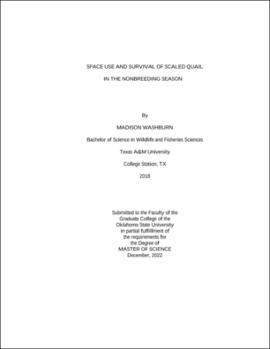| dc.contributor.advisor | Elmore, R. Dwayne | |
| dc.contributor.author | Washburn, Madison | |
| dc.date.accessioned | 2023-04-17T15:33:07Z | |
| dc.date.available | 2023-04-17T15:33:07Z | |
| dc.date.issued | 2022-12 | |
| dc.identifier.uri | https://hdl.handle.net/11244/337411 | |
| dc.description.abstract | Scaled quail (Callipepla squamata) occur throughout the Chihuahuan Desert and the southwestern United States. Scaled quail populations have been declining over recent decades and factors influencing this decline are not fully understood. Research pertaining to factors influencing nonbreeding season scaled quail survival and space use is limited. To address research gaps about scaled quail habitat use, we investigated scaled quail survival and resource selection during the nonbreeding season. We used radio-telemetry to monitor scaled quail movements and survival. We measured vegetation at points used by quail and available points and analyzed the effect of land cover and distance to landscape features that may influence scaled quail space use and survival. Nonbreeding season scaled quail home ranges during the nonbreeding season were strongly linked to anthropogenic areas with a variety of man-made cover. They also selected for higher densities of tall shrubs (>1.5 m) that were mostly comprised of tree cholla. Survival of scaled quail was lower with closer proximity to tree cholla and in areas with higher percent cover of low-level shrubs (<1.5 m). As nocturnal ecology of scaled is poorly understood, we also recorded roost site locations and conducted a covey flushing experiment to examine the effects of late-evening flush events on roosting dynamics. We randomly assigned coveys into control and treatment groups, and treatment groups were flushed <1 hour from official sunset twice per week. We recorded vegetation measurements at roost points and within 15 m at the roost array. Scaled quail coveys selected roost points with less grass cover and more low-level vertical obstruction at the roost array scale (within 15 m). We found that microclimates at roost points were cooler than what was randomly available. Even so, we found a negative effect of lower average minimum daily temperatures on survival of nonbreeding scaled quail. From our covey flushing experiment, we found that coveys disturbed <1 hour from sunset frequently regrouped to roost together and did not have lower survival than control groups. Our results emphasize the importance of cover availability and structure heterogeneity required by scaled quail coveys throughout the nonbreeding seasoning. | |
| dc.format | application/pdf | |
| dc.language | en_US | |
| dc.rights | Copyright is held by the author who has granted the Oklahoma State University Library the non-exclusive right to share this material in its institutional repository. Contact Digital Library Services at lib-dls@okstate.edu or 405-744-9161 for the permission policy on the use, reproduction or distribution of this material. | |
| dc.title | Space use and survival of scaled quail in the nonbreeding season | |
| dc.contributor.committeeMember | Davis, Craig | |
| dc.contributor.committeeMember | Prendergast, Jeffrey | |
| osu.filename | Washburn_okstate_0664M_17916.pdf | |
| osu.accesstype | Open Access | |
| dc.type.genre | Thesis | |
| dc.type.material | Text | |
| dc.subject.keywords | habitat management | |
| dc.subject.keywords | nonbreeding season | |
| dc.subject.keywords | roosting ecology | |
| dc.subject.keywords | scaled quail | |
| dc.subject.keywords | survival | |
| thesis.degree.discipline | Natural Resource Ecology and Management | |
| thesis.degree.grantor | Oklahoma State University | |
